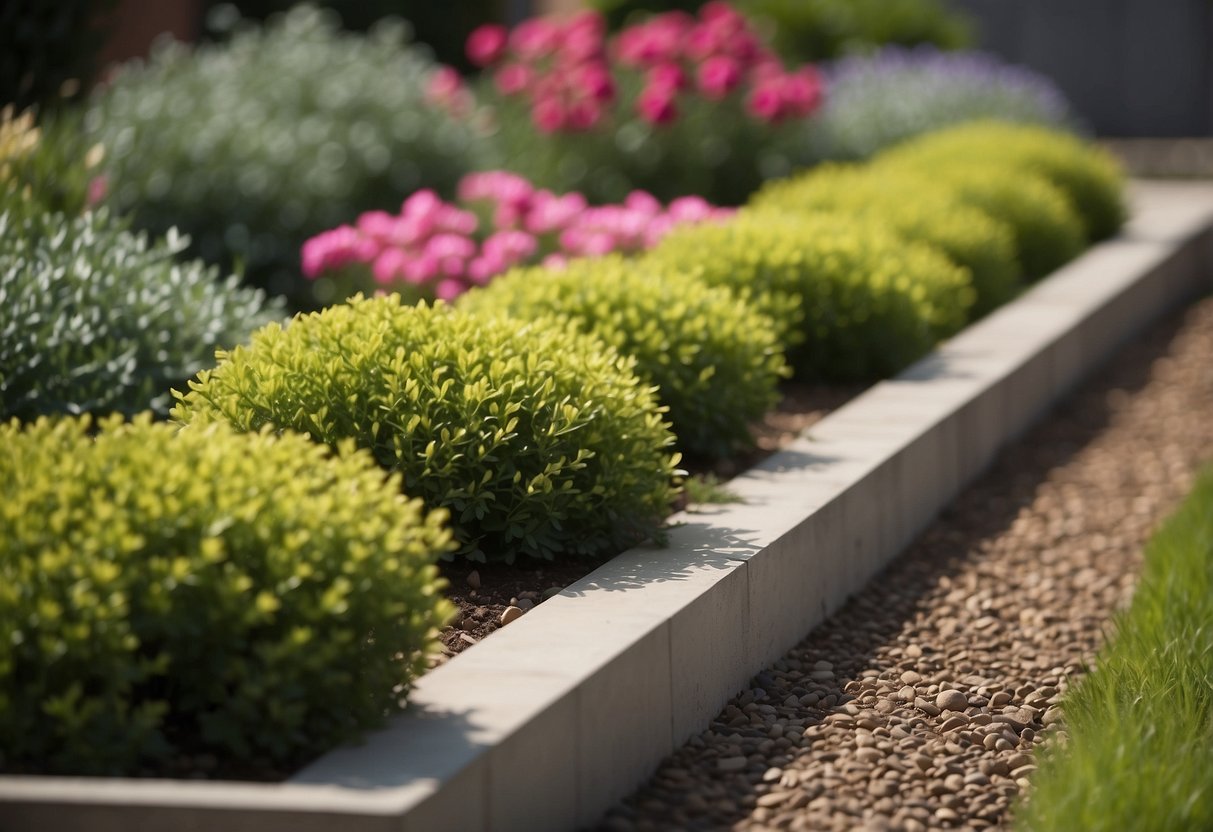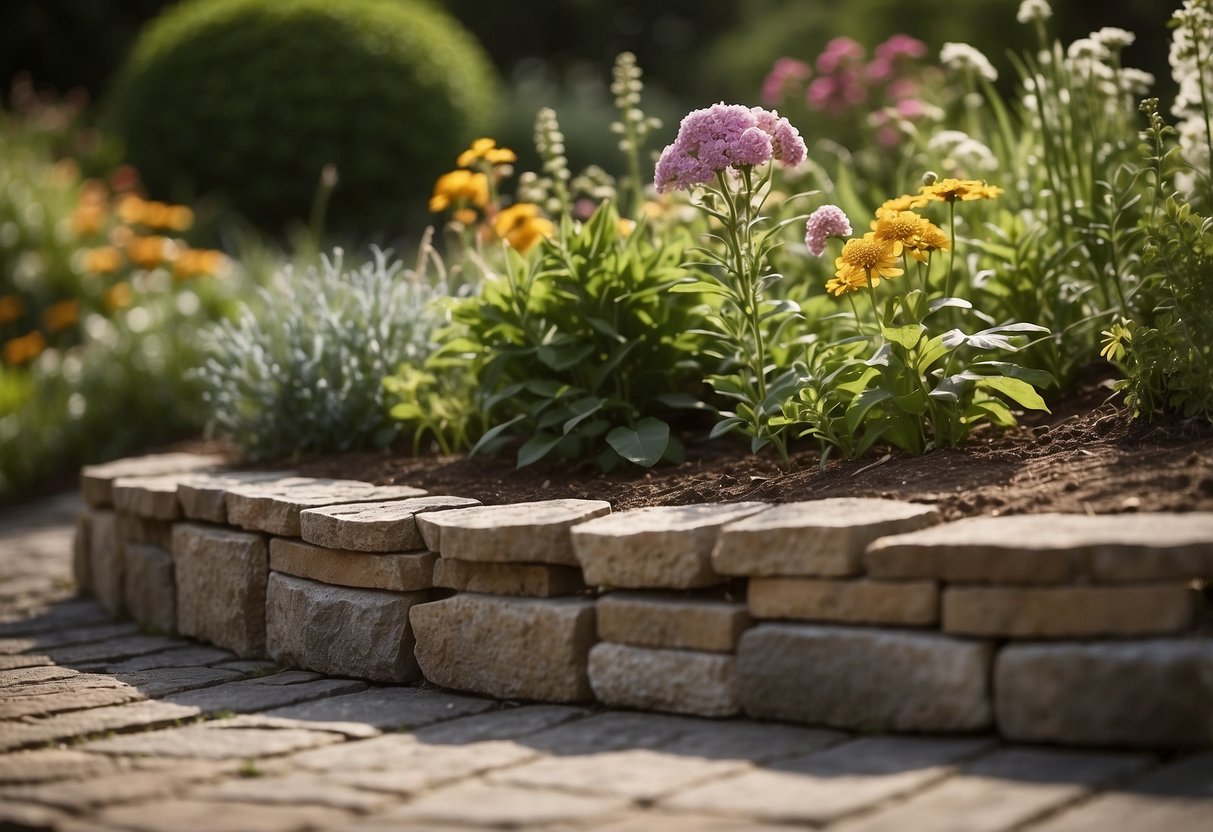Garden Edging Ideas: Creative Borders for Your Outdoor Space
Keeping your garden looking neat and defined can be a challenge, but garden edging can be a game-changer. Whether you’re working with a large yard or a small city garden, the right edging can add curb appeal and help you manage plant growth and maintenance. Looking for ways to make your garden pop? We’ve got you covered with a variety of garden edging ideas.

Explore different materials and methods that can transform your green space. From classic stone and brick to creative options like recycled materials, there’s something to suit every style and budget. With the right garden edging, you can create visually pleasing borders that enhance your overall landscape.
1) Classic Brick Edging

Classic brick edging is a timeless way to frame your garden.
First, dig a trench where you want the bricks. Make sure it’s deep enough for stability.
Place the bricks tightly next to each other. Fill the gaps with soil or mortar for a neat finish.
For a sturdy base, consider using a sand and cement mix. This helps keep the bricks in place.
This method works well with different garden styles.
Maintain it by checking for loose bricks and adjusting them as needed.
Classic brick edging is both elegant and functional for any garden.
2) Charming Cobblestone Border

Cobblestone borders add a touch of timeless charm to any garden. You can place these stones tightly together or with small gaps for a more rustic feel.
Cobblestones are very durable. They handle weather changes well, so you won’t need to replace them often. Plus, the natural look of cobblestones blends beautifully with plants and flowers.
3) Modern Metal Lawn Edging

Modern metal lawn edging is a sleek and stylish way to define your garden spaces. Metal options, such as steel or aluminum, offer durability and a clean look.
You can use metal edging to create clean lines between flower beds, lawns, and walkways. This helps keep mulch and soil in place.
It’s also a low-maintenance option. Metal resists weathering and can easily be shaped to fit any garden design. Adding modern metal edging can make your garden look more polished and organized. For more ideas, check out these modern garden edging ideas.
4) Timber Railway Sleepers

Using timber railway sleepers is a great way to add a natural look to your garden. They are sturdy and durable, making them perfect for edging.
You can use sleepers to create raised planters. This helps to keep your garden organized and looking neat. Timber railway sleepers can also make excellent borders for flower beds or walkways.
For a unique touch, consider using sleepers to frame a small pond. This adds a rustic charm that enhances the beauty of your garden.
Find more creative ideas for railway sleepers and transform your outdoor space.
5) Rustic Log Rolls

Using rustic log rolls for garden edging can give your yard a natural, cozy look. This style fits well with classic farmhouse designs.
These log rolls are easy to set up and can be shaped to fit your garden’s layout. They work nicely around flower beds, grassy areas, and pathways.
Repurposing old wood for log rolls is a great way to recycle materials. It’s a simple yet effective way to enhance your garden’s charm.
You can learn more about log roll garden edging to transform your space beautifully.
6) Upcycled Bottle Borders

Using upcycled bottles for garden edging is a fun and eco-friendly idea. It adds a splash of color and charm to your garden.
You can bury the bottles neck down so that the bottoms create the edging. This method works well with bottles of all colors.
Mix and match different bottle heights for a unique look. This adds a whimsical touch to your garden’s edge.
Upcycling bottles not only looks great but also helps reduce waste. It’s a win-win! Check out some ideas here.
7) Elegant Concrete Curbing

Concrete curbing is a stylish way to define your garden. It offers a clean, modern look that suits many garden styles.
You can choose different shapes and sizes to fit your garden’s needs. This flexibility makes concrete curbing a popular choice.
Concrete is durable and low-maintenance. It holds up well against the elements and doesn’t require much upkeep.
8) Natural Stone Edging

Natural stone edging can add a touch of elegance to your garden. It uses stones in their natural form to create borders.
You can use large boulders or smaller stones depending on your garden’s look. Natural boulder stones are durable and can withstand the elements for years.
This type of edging works well with rustic or traditional garden styles, creating a timeless look. For more ideas, check out this guide on natural stone edging.
9) Woven Willow Fence

A woven willow fence adds a touch of rustic charm to your garden. It’s both functional and decorative, providing a natural barrier.
You can create sections to separate different garden areas. This fence style is great for privacy too.
A woven willow fence is easy to install. It’s a lovely, eco-friendly choice for any garden. To learn more ideas, check out garden must-have: woven willow fences and trellises.
10) Paver Stone Designs

Paver stone designs can transform your garden and make it look stunning. You can use natural stone pavers, like limestone, granite, or flagstone. These materials give your garden a touch of natural elegance and blend well with the environment.
Brick pavers are another classic choice. They bring warmth and can fit any garden style, from English cottage to modern. Plus, brick pavers are known for their durability and versatility.
For a modern look, try staggered pavers. They create straight-line edging and work great for smaller gardens and flower beds.
Importance Of Garden Edging

Garden edging plays a crucial role in boosting the look of your garden, while also providing clear boundaries for different sections. These benefits make your garden not only beautiful but also practical.
Enhancing Curb Appeal
Garden edging can greatly improve the first impression of your home. Neatly defined edges provide a polished look, making your yard stand out.
Using edging materials like stone, wood, or metal can add texture and contrast, making plants and flowers more noticeable. For example, rock edging can highlight colorful blooms and give a unique touch to your garden.
You can also use different shapes and patterns to make your garden visually interesting. Keeping your garden well-edged helps maintain a tidy and organized look, enhancing the beauty of your outdoor space.
Defining Garden Spaces
Garden edging helps you organize different parts of your garden. By separating flower beds, lawns, and paths, you create distinct areas that are easy to manage.
For instance, using cedar lumber is great for straight runs of edging, as it resists decay and insects, ensuring your garden edges stay in good condition.
Edging also prevents grass and weeds from invading flower beds, reducing maintenance. Plus, it keeps soil and mulch inside the borders, providing better growing conditions for your plants. Clear divisions make it easy to decorate and plan your garden layout, ensuring everything has its place.
Material Choices For Garden Edging

Choosing the right material for garden edging can enhance your garden’s appearance and functionality. Whether you prefer the natural look of stone or want to upcycle old materials, there is an option to fit every style and budget.
Natural Stone
Natural stone is a sturdy and attractive choice. It includes materials like granite, limestone, and sandstone. Granite is extremely durable and offers a sleek appearance. Limestone is softer, making it easier to shape for custom designs. Sandstone adds a rustic charm and blends well with various plants.
These stones are available in different sizes and shapes, allowing for flexible design options. They can be stacked for height or laid flat for a subtle border. Maintenance is minimal, just occasional cleaning and repositioning of shifted stones.
Recycled Materials
Using recycled materials is both eco-friendly and cost-effective. Old bricks are popular and provide a classic look. They can be laid horizontally or vertically, depending on your preference. Glass bottles can create a whimsical edge by burying the necks in soil, and they come in various colors for a unique touch.
Metal and wood scraps can also be repurposed into creative borders. Reclaimed wood planks, when treated properly, can make a rustic edge. Metal roofing sheets, cut into strips, offer a modern and industrial feel. These materials not only add character to your garden but also promote sustainability.
Wood Types
Wood is a versatile choice for garden edging. Cedar is a popular option due to its resistance to rot and insects. It is long-lasting and requires little maintenance. Bamboo is excellent for a Zen or tropical garden. It’s nearly indestructible and comes in various sizes for different border heights.
Treated pine is another cost-effective option and can be painted to match your garden’s theme. Log rolls, made from connected wooden logs, offer a natural and rounded look. Keep in mind that untreated wood may need occasional sealing or staining to prolong its life.







